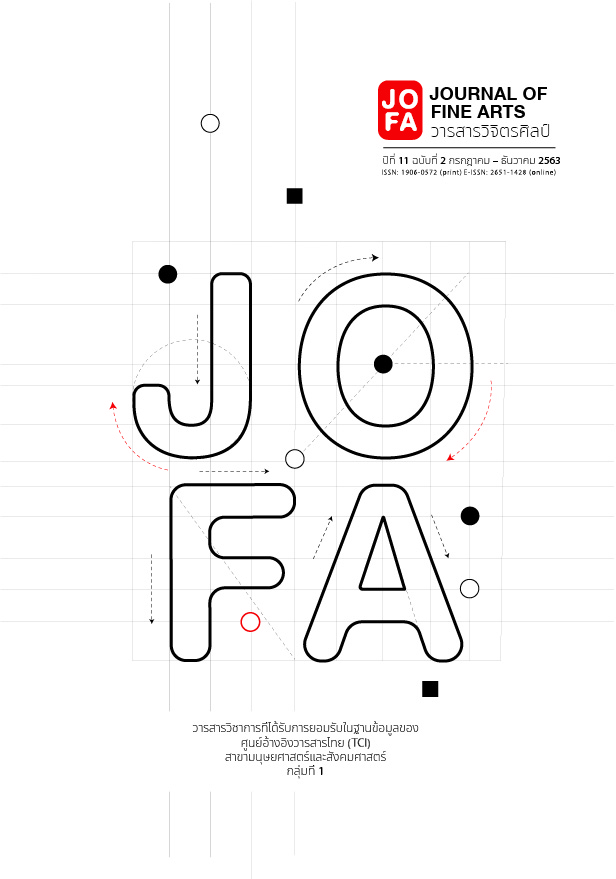Wat Koh Traditional Woodcraft School Preaching Canopies: Historical Objects in Phetchaburi Bourgeoisie Cultural Context Historical Objects in Phetchaburi Bourgeois Cultural Context
Main Article Content
Abstract
The article investigates Phetchaburi social history during important craftsmanship period in the last 25 Buddhist centuries. The researcher studied 4 pieces of Wat Koh traditional woodcraft school preaching canopy to study complexity of sociocultural local context in assumption that the flourished and collapsed of Phetchaburi traditional craftsmanship was connected to economic changing in the former and latter in 25 Buddhist centuries. The results showed that the groups of craftsmanship patrons were a bourgeois that made their status in economic export by rice and sugar trade and land rent. They made merit by dedicate preaching canopy for religious to make their status. Wat Koh traditional woodcraft school preaching canopy had been.made.around 1922 – 1966 (A.D.) spread away by social relational network between temple, craftsman, and patrons.This study found various socio-cultural dimensions; For instance, traditional craftsmanship culture, patron’s social existence, and social relationship network that bound them up. The craftsman patronage in local context is a significant channel to understand Phetchaburi bourgeois social existence in this period.
Article Details
References
Aphō̜n suwan, T. Khwāmkhit Kānmư̄ang Phraikradumphī Hǣng Krung Rattanakōsin. [Political thinking of Proletarian Bourgeoisie of Rattanakosin period]. Bangkok: Matichon, 2006.
Appadurai, A. The Social Life of Things: Commodities in Cultural Perspective. Cambridge: Cambridge University Press, 1986.
Ā sa wai, S. Prawat khlō̜ng Rangsit: kānphatthanā thīdin læ phonkrathop tō̜ sangkhom 1888 - 1914. [History of canals: land development and effect to society in 1888 - 1914]. Bangkok: Thammasat University Press and Foundation for the Promotion of Social Sciences and Humanities Textbooks Project, 1987.
Atsawinānon, N. Khwām Plīanplǣng Thāng Sangkhom Læ Sētthakit Khō̜ng Mư̄ang Phet Burī 1857 – 1917. [The social and economic changes of Phetchaburi capital (1857-1917 A. D.)]. Master’s Thesis. Bangkok: Chulalongkorn University. 1992.
Bradley, Beach D. Nưng satawat nai Sayām.1828 - 1928: prawat sangkhēp khō̜ng phantha kit Khrittačhak prōtēttǣn nai Sayām. [One hundred year in Siam 1828 - 1923: a brief history of Protestant mission in Siam]. Bangkok: Inter publishing Enterprise, 2012.
Bun Tœ̄p Phannarā. Interview by Mekmok, C., October 11, 2018.
Čhǣm Čhan, B. Chāng Mư̄ang Phet: Anusō̜n Nai Ngān Phrarātchathān Phlœ̄ng Sop Phū Chūai Sāttrāčhān Būa Thai Chaemchan, June 21 1992. [Phetchaburi craftsman: a memorial to the cremation of Asst. Prof. Chamchan, B. June 21, 1992]. Phetchaburi: Petchpoom. 1992.
Iaosīwong, N. Pākkai Læ Bai rư̄a: Rūam Khwām Rīang Wādūai Wannakam Læ Prawattisāt Ton Rattanakōsin. [Beak and sails: total treatise about literatures and history in an early Rattanakosin period]. Bangkok: Fadiaokan, 2012.
Ingram, James c. Kānplīanplǣng Thāng Sētthakit Nai Prathēt Thai 1850 – 1970. [Economic change in Thailand since 1850 - 1970]. Bangkok: Toyota Thailand Foundation, The Foundation for the Promotion of Social Sciences and Humanities Textbooks Project, 2009.
Kœ̄t Čharœ̄n, S. Phrabāt Somdet Phra Čhō̜mklao Čhaoyūhūa Kap Mư̄ang Phet Burī. [King Mongkut and Phetchaburi city]. Phetchaburi: Phetchpoom, 1999.
Lowe, Donald M. History of Bourgeois Perception. Chicago: University of Chicago Press. 1982.
Miller, D. “Artifacts and the Meaning of Things.” 1994. In Ingold, T. Companion Encyclopedia if Anthropology. London: Routledge, 2002.
Mekmok, C. Samnak Læ Kān Sư̄p Sān Ngān Chāng Mai Sāi Sakun Chāng Mư̄ang Phet. [Schools and continuation of Phetchaburi traditional wooden craftsmanship]. The Thailand research Fund, 2017.
__________. Thammāt mư̄ang phet: Phonlawat Khō̜ng Watthanatham Ngān Chāng Mai Nai Bō̜ribot Watthanatham Thō̜ngthin. [Phetchaburi peaching canopies: dynamic of traditional craftsmanship culture in local culture context]. Walailak Journal of Social Science. 11 (2) (July - December), 2018: 139 - 168.
Na pāknam Nor. Thammāt: Sak Læ Sī Hǣng Sinlapa Thai. [Peaching canopies: prestige of Thai art]. Bangkok: Mueng Boran, 2001.
Nāi hon hūai. Mō̜p Lat Bok Ru Ngō̜ Sayām . [Bradley and Siam society]. Bangkok: Ratchadarom, 1985.
National Archives of Thailand. Sāntrā Wādūai Nam Tang Nāiʻākō̜n Tao Mō̜nam Tān. [Deed about leading to tax farmer of fresh sugar pot stove]. Royal secretary, King Mongkut, stapled document, Ministry of defense 5/7 1859, 32.
Phetcharopamakhun. Wat ko̜. [History of Wat Koh]. In Phiboonsombat, B. (Ed.). Wat Koh, Phetchaburi. Phetchaburi: Petchpoom, 2000.
Prown, Jules D. “Mind in Matter: An Introduction to Material Culture Theory and Method.” in Winterhur Portfolio, Vol. 17, No. 1. (Spring, 1982): 1 - 19.
Singkhān Wāt Wīang Chai. Interview by Mekmok, C., October 19, 2018.
Thai Khadi Research Institute . Mō̜p Rat Lē Kap Sangkhom Thai. [Bradley and Thai Society] Bangkok: Thammasat University Press, 1985.
Thō̜ngbai Krachang Kǣo. Interview by Mekmok, C. December 28, 2018.
Ying Amēthi. Interview by Mekmok, C. July 28, 2017.


